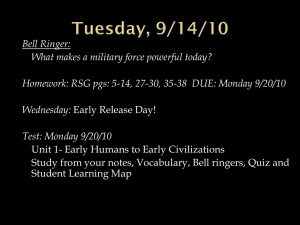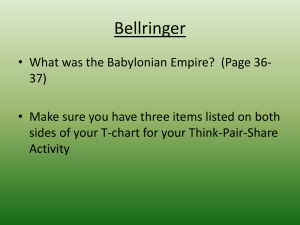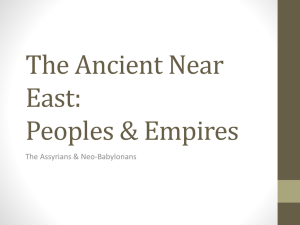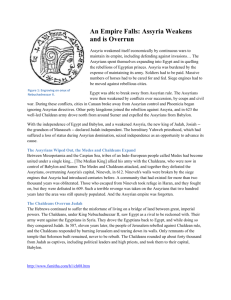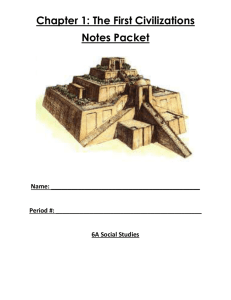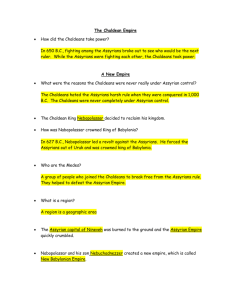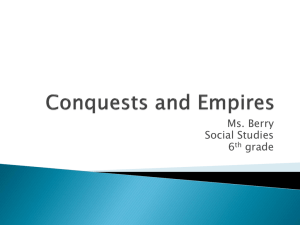The Legend of Gilgamesh the First Superhero!
advertisement
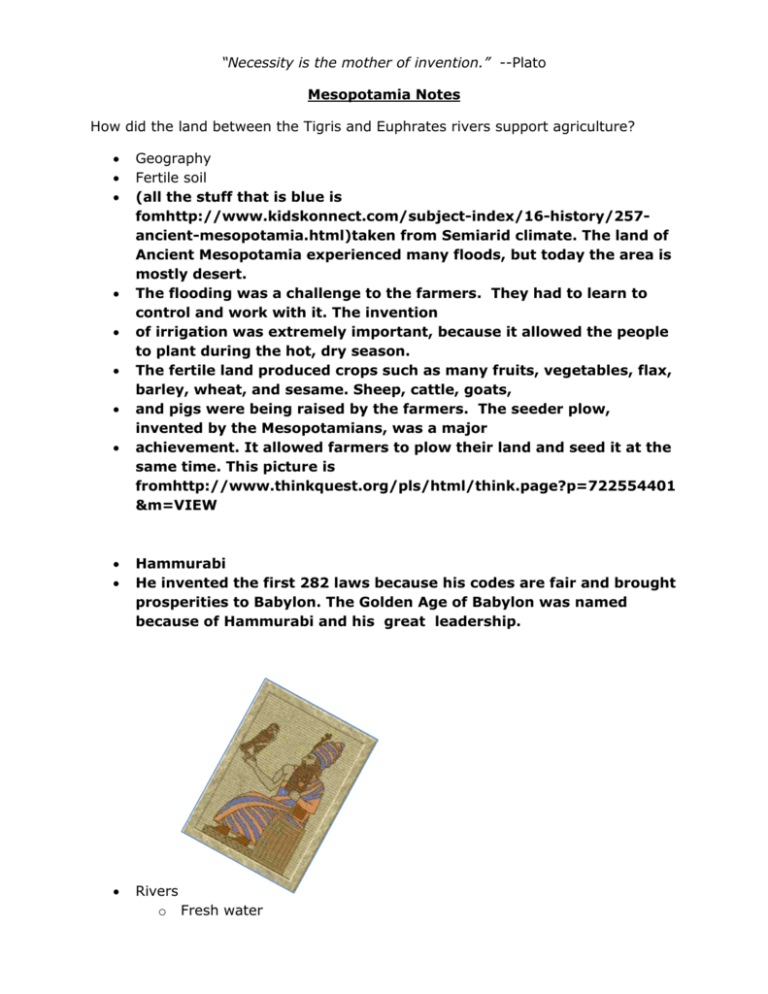
“Necessity is the mother of invention.” --Plato Mesopotamia Notes How did the land between the Tigris and Euphrates rivers support agriculture? Geography Fertile soil (all the stuff that is blue is fomhttp://www.kidskonnect.com/subject-index/16-history/257ancient-mesopotamia.html)taken from Semiarid climate. The land of Ancient Mesopotamia experienced many floods, but today the area is mostly desert. The flooding was a challenge to the farmers. They had to learn to control and work with it. The invention of irrigation was extremely important, because it allowed the people to plant during the hot, dry season. The fertile land produced crops such as many fruits, vegetables, flax, barley, wheat, and sesame. Sheep, cattle, goats, and pigs were being raised by the farmers. The seeder plow, invented by the Mesopotamians, was a major achievement. It allowed farmers to plow their land and seed it at the same time. This picture is fromhttp://www.thinkquest.org/pls/html/think.page?p=722554401 &m=VIEW Hammurabi He invented the first 282 laws because his codes are fair and brought prosperities to Babylon. The Golden Age of Babylon was named because of Hammurabi and his great leadership. Rivers o Fresh water o o Means of travel For Bathing How did climate affect farmers? Unpredictable floods Unpredictable droughts Irrigation Slight rain How did Mesopotamians cope with a lack of resources? Mud houses and walls Trade Surplus of grain wood was in short supply The Ancient Mesopotamians developed the arch and column. They were masters of construction using bricks made of mud. Brick-making was a major Mesopotamian industry, especially in the south, where wood was in short supply and there was no stone. Over the centuries, rains and shifting sands destroyed much of southern Mesopotamia's mud-brick architecture. Only crumbled mounds remain as evidence of the great cities that once stood in the deserts of southern Iraq Basic Traits of Civilization Advanced cities Specialized workers Examples from Sumer It is believed an ancient site called Eridu, was the first city that was ever created. They built permanent homes of sun-dried bricks made of mud and straw, and started a new life in the southern region of ancient Mesopotamia.( http://mesopotamia.mrdonn.org/sumer.html) Complex institutions The (http://mesopotamia.mrdonn.org/homes.html) rich lived in large homes, and the poor lived in smaller homes, but nobody lived in huts. Some of the larger homes were wide as well as high, but nearly all the homes were three stories high. Rich and poor, most homes were clustered around the Ziggurat and each other. Most houses shared walls, like townhouses do today. There was little wood and stone available for building materials. People built their homes of sun-dried brick. Doors led into a small family courtyard Record keeping They use pictures for keeping the record, then switched to cuneiform, cuneiform is basically like the Chinese symbol. They also used something called rebus, it is like this.( means growing economy. It was important to have these languages so people can understand you. Advanced technology My name in Babylonian is like this. (http://www.ask.com/questions-about/WhatIs-the-Complex-Institutions-of-Mesopotamia) Sumerians first to make city states, discovered the wheel, made metal work, weapon and tool, built with block made with mud, high walls to protect the city from enemies, enough food from farming that allowed them to do another thing for ex.... they also made the numbers to use in math but not counting zero. Today we use most of the Sumerians first inventions but more advanced. What type of community developed in Sumer? City states Ziggurats Sumerian religion Polytheism Anu was the father of the gods and the god of the sky * Enlil was the god of the air * Utu was the sun god and the lord of truth and justice * Nanna was the moon god * Inanna was the goddess of love and war * Ninhursag was the goddess of earth * Enki was the god of fresh water as well as the lord of wisdom and magicziggurat Sumerian society Social classes Slaves Roles of womenThe Mesopotamian woman's role was strictly defined. Most girls were trained from childhood for the traditional roles of wife, mother, and housekeeper. They learned how to grind grain, how to cook and make beverages, especially beer, and how to spin and weave cloth for clothing. Around twelve years of age, a young girl was considered ready for marriage. Sumerian science and technology Early invention During the earliest years of recorded history, the Ancient Mesopotamians were experimenting With ways to count, measure, and solve mathematical problems. They were the first to give a number a place value and to recognize the concept of zero. They invited the brick to make stronger and more reliable. They were the ones who invented the plow and the seeder. Creation of Written language Picture writing Cuneiform Literature- Epic of Gilgamesh6. The Sumerians of Ancient Mesopotamia are credited with inventing the earliest form of writing. The writings on tablets were of simple pictures, or pictograms, which represented an object or an idea. Clay is a difficult material to draw on so the Mesopotamians eventually reduced pictograms into a series of wedge-shaped signs that they pressed into clay with a stylus. This wedge-shaped writing is called cuneiform. This invention of writing was a huge advancement, because it allowed information to be carried from place to place accuratelyAkkadian Empire Sargon Created world’s first empire (group of many different lands under one ruler) One ruler, one government Encouraged writing Lasted 200 years 2300 Great king Babylonians Hammurabi o Code of Laws o Justice o Rights to people o Legacy o King Nebuchadnezzar o King Nebuchadnezzar II o Great king who brought them together has an empire. Accounts indicate that the garden was built by King Nebuchadnezzar, who ruled the city for (4http://www.cleveleys.co.uk/wonders/gardensofbabylon.htm)3 years starting in 605 BC (There is a less-reliable, alternative story that the gardens were built by the Assyrian Queen Semiramis during her five year reign starting in 810 BC). This was the height of the city's power and influence and King Nebuchadnezzar constructed an astonishing array of temples, streets, palaces and walls. According to accounts, the gardens were built to cheer up Nebuchadnezzar's homesick wife, Amyitis. Amyitis, daughter of the king of the Medes, was married to Nebuchadnezzar to create an alliance between the nations. The land she came from, though, was green, rugged and mountainous, and she found the flat, sun-baked terrain of Mesopotamia depressing. The king decided to recreate her homeland by building an artificial mountain with rooftop gardens. Assyrians Ferocious army Set fire to buildings Chariots, battering rams, ladders, tunnels Iron tipped weaponry from Hittites Cavalry Punishment, taxes, moved people to foreign territories once captured (exiled) First libraries by Ashurbanipal in Nineveh 20,000 tablets: dictionaries, myths, stories, science, geography, medicine, religion Made many enemies, two enemies (Medes & Chaldeans) joined forces to defeat them The Assyrians were the first one to make a aqueduct to bring water from miles away. The Assyrians had a powerful army. By 1100 B. C., they had defeated their neighboring enemies. By 800 B. C., they had taken over cities, trading routes and fortresses all over Mesopotamia. Their capital, Nineveh, was then the center of Mesopotamian civilization. The Assyrian army well organized. It was divided into groups of foot soldiers armed with shields, helmets, spears, and daggers. It also had chariots, cavalry, and archers. In the beginning, the Assyrians fought only in the summer when they did not have to be concerned about planting or harvesting crops. Later, soldiering became a year round job. [ http://library.thinkquest.org/J002807/Time%20and%20Time%20Again/Time%20and %20Time%20Again/mesoassyr.html Assyrian power was partly due to their weapons, which were made of iron. Iron was harder and stronger than copper or tin. Iron had been used in the Middle East for many centuries, but until 1400 B. C., it was too soft to be made into weapons. Then, the Hittites developed the process of smelting. The Assyrians borrowed this skill from them. Chaldean Nebuchadnezzar II- rebuilt Babylon and made Ishtar Gate Ziggurat- Tower of Babel (http://en.wikipedia.org/wiki/ChaldeaHanging) G The Chaldean's homeland was in the relatively poor country in the far south of Mesopotamia, at the head of the Persian Gulf. The Chaldeans first came to prominence in the late 8th Century BC. Marduk-apla-iddina II (the Biblical Merodach-Baladan) of Bit-Yâkin, allied himself with the powerful Elamite kingdom and seized control of Babylon in 721 BC after the death of the Assyrian king Shalmaneser V who had ruled Babylon directly from Nineveh. The new king of Assyria Sargon II attacked and deposed Marduk-apla-iddina II in 710 BC. After defeat by the Assyrians he fled to his protectors in Elam. In 703 he briefly regained the throne from a native Babylonian ruler Marduk-zakir-shumi II who had ascended the throne after a revolt in Babylon against the Assyrian king, Sennacherib. He was once more defeated at Kish, and again fled to Elam where he died in exile after one final attempt to raise a revolt against Assyria in his homeland, Bit-Yâkin in 700BC. Babylon was then ruled by a native Babylonian puppet of the Assyrians Belibni, he was replaced by Ashur-nadin-shumi an Assyrian prince who was murdered by the Elamites and replaced with a native Babylonian Elamite puppet Nergal-ushezib. The Chaldeans briefly regained control of Babylon in 693 BC when the populace deposed Nergal-ushezib, and chose MushezibMarduk, a Chaldean prince to replace him. However, this was short lived, and Sennacherib sacked Babylon, destroying the city in 689 BC routing the Babylonians, the Chaldeans of Bit-Yâkin and their Elamite backers in the process. Sennacheribs successor as king of Assyria, Esarhaddon rebuilt Babylon, but for the next 73 years Babylon remained under Assyrian control. It was only in 620 BC under Nabopolassar that the Chaldeans finally gained control over Babylon, founding the Chaldean Dynasty. After the death of Ashurbanipal, the last great Assyrian king in 627 BC, Assyria descended into a period of bitter civil war. A rebellious Assyrian general Sin-shumu-lishir briefly set himself up as king in Babylon, but was ousted by Ashur-etil-ilani the legitimate king of Assyria. Further civil war erupted with Sin-shar-ishkun seizing the throne of Assyria from his brother Ashur-etil-ilani . Nabopolassar took advantage of all this to seize a rebellious Babylon. Bitter fighting continued in the region from 627 to 620 BC, the final straw was another massive rebellion in Assyria while its king Sin-shar-ishkun was marching on Babylon in an attempt to regain control. Nabopolassar seized Nippur and thus Babylonia as a whole. Nabopolassar's position, and the fate of Assyria was sealed when he entered into an alliance with another of Assyria's former vassals, the Medes, the now dominant people of what was to become Persia. The Medes, and Chaldean ruled Babylonians, together with the Scythians and Cimmerians attacked Assyria in 616 BC, and by 612 BC the alliance had sacked Nineveh, killing Sinsharishkun in the process. Nabopolassar and his allies were now in possession of the huge Neo Assyrian Empire. An Assyrian king Ashuruballit II held out at Harran, resisting until 605 BC, when the remnants of the Assyrian Army and an Egyptian force were defeated at Karchemish.ardens of Babylon The Legend of Gilgamesh the First Superhero! The part I liked about the story about King Gilgamesh mainly because of many reasons. One he can go to the deepest spot in the ocean I one breathes. Then I liked the part when the story said that really got his camel. My favorite part was when the gods sent Enkidu a bigger challenge so Gilgamesh can be a god. But alas, instead of fighting they became best friends and went for an adventure Hammurabi Hammurabi is a little strict because most of them involved death but for a very good reason like for rule number 22 if anyone is committing a robbery and is caught, then he shall be put to death. If I was very important of Hammurabi codes because he was a great leader for thinking this because the city of Babylon was called The Golden Age of Babylon because After watching this video, what did the Assyrians have as an advantage that helped them conquer the Babylonians? Well the Babylonians didn’t had is a great military and the horse because the Assyrians were a more farming people and the Assyrians designed carrot and shield to conquer empires. The Assyrians were the first one to make an aqueduct to bring water from miles away.
